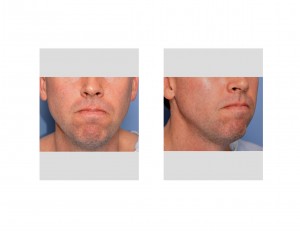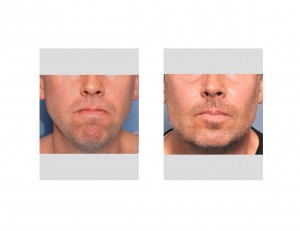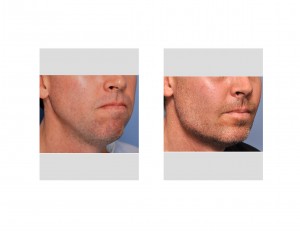Background: The aesthetic appearance of the lower third of the face is defined largely by the size and shape of the underlying jaw bone. The support that the bone provides in the transition of the face into the neck creates one of the face’s most distinctive features. There are three aesthetic zones to this jawline including the chin, body and jaw angles. Like the chin in the front, the jaw angles provide the definition to the back of the jaw.
There is usually some correlation between the strength of the chin and the prominence of the jaw angles. As the overall mandible becomes weaker or more underdeveloped, the jaw angle area rotates upward. (becomes shorter) Known as the mandibular plane angle, stronger jaws have less of a plane angle than those that are weaker. This makes them vertically longer and slightly more wide.
Thus when evaluating the jaw angle area, it is important to determine if the deficiency is just one of overall width (desire for more flare or prominence) or whether the problem is more three-dimensional. (combination of vertical shortness and width) The clue to that diagnosis is almost always in the forward position of the chin. The weaker the chin, the shorter the jaw angles and the greater vertical deficiency they have.
In patients seeking jaw angle enhancement, the correct diagnosis of the jaw angle anatomy is critical for this controls the style of jaw angle implant selected. While the size of the implant is also important, no good result can be achieved if the proper style is not selected.
Case Study:



Jaw angle implants can make a dramatic difference in the jawline and be very complementary with chin augmentation. Choosing the right implant style is critical. Size estimation with jaw angle implants, however, remains very subjective and lacks any objective method for selection. Over-correction and asymmetry remains the biggest reasons for revisional surgery with this type of facial implant.
Case Highlights:
• Jaw angle augmentation is a part of overall jawline enhancement and is often done in combination with chin augmentation.
• Jaw angle augmentation can be done either as a two-dimensional change (width and greater angle definition) or three-dimensional. (width, vertical length and angle definition)
• Jaw angle implants are placed through an intraoral approach in a submuscular position. The greatest risks with their use are the aesthetics of symmetry and size.
Dr. Barry Eppley
Indianapolis, Indiana


